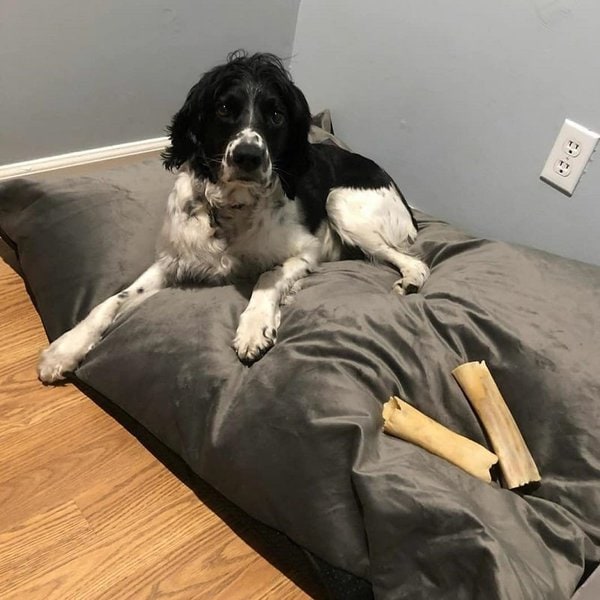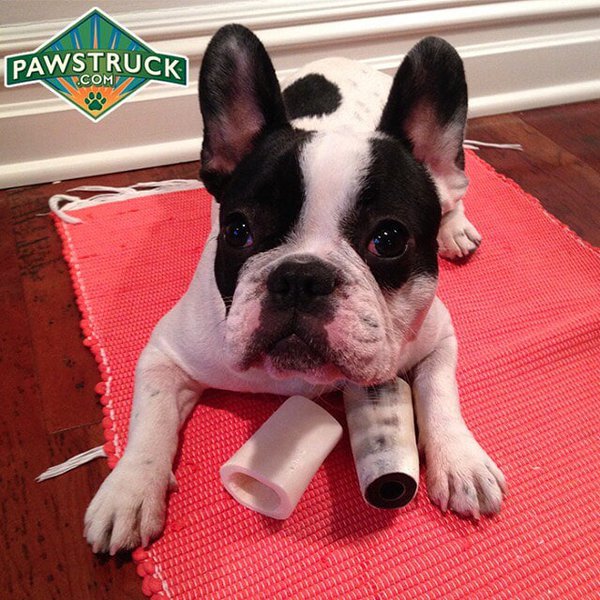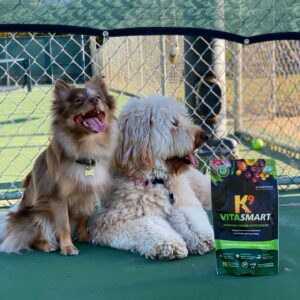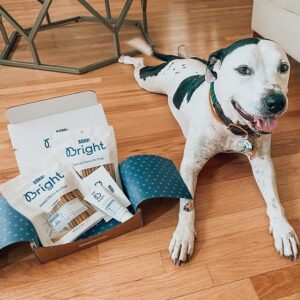The best dog bones for aggressive chewers is K9 Connoisseur Natural Marrow Filled Bone Dog Bones.
It’s in your dog’s nature to chew. Chewing is a perfectly normal behavior typically seen in younger puppies and adult dogs.
However, there are instances whereby your dog has developed aggressive or destructive chewing behaviors. When this happens, you will come home to find that your dog has once again chewed a piece of your couch or ruined one of your shoes.
Thankfully, there are ultra-durable dog bones that are specially made for aggressive chewers. These will help to keep your pooch entertained for a long time while ensuring that your items are safe from getting destroyed.
Below is a list of the best dog bones for aggressive chewers on the market, complete with key features and a detailed buying guide to help you choose the best option for your pup.
#1 K9 Connoisseur Natural Marrow Filled Bone Dog Chews
If your dog is an aggressive chewer, then you’ll love this sturdy dog bone chew toy from Lilly’s Choice. This long-lasting dog chew is specially designed for aggressive chewers that enjoy incessantly chewing on anything they can get their teeth on.
No matter how much slobber your power chewer dog gets on this dog chew, it won’t grow mold or crack because it’s made to withstand even the most persistent chewing, and without your dog’s teeth getting stuck. Not only that, but this dog chew has a hollow center that you can refill with treats so they’ll never get bored with it.
Plus, it’s available in various sizes, including 3, 6, and 12 packs.
These delicious dog bones are loved by dogs of all breeds because they’re sturdy, long-lasting, and flavorful. As a dog owner, you’ll have peace of mind knowing that you’re providing the best for your aggressive chewers as this chew is certified by the Global Safety Institute.
Pros
- As a trusted local brand, you can be certain that K9 Connoisseur’s line of products is made from grass-fed cattle born and raised in the USA.
- These natural chews are made with only one ingredient and nothing else.
- Is considered safe and healthy for pups because it does not contain any artificial flavoring or chemical additives.
- Has low calories and only contains about 30% minimum protein, which keeps pups lean and strong.
- It is great tasting marrow-filled bones that are hickory smoked, which give the hanging pieces of meat that natural flavor.
Cons
- It can be unsafe for larger dogs as some of them can break the bone into pieces, and this presents a choking hazard.
- It can be costly because some doggies lose interest in the bone once they finish the marrow and meaty parts.
This product is our top pick because it contains no fancy ingredients but grass-fed and free-range beef, and it is also low in calories, making it perfect as a dog training reward
#2 Pawstruck Filled Dog Chews
Proudly made in the USA from femurs, the Pawstruck dog bones come in a variety of scrumptious flavors for your aggressive chewers to chew and enjoy, including peanut butter, bacon, and cheese.
Yum! You’ll be glad to know that these dog bones are made with your dog’s dental health in mind and can help to eliminate the build-up of plaque and tartar to keep your pup’s teeth and gums clean.
There are usually 5 to 6 femur bones in each pack, and each long-lasting dog chew contains a different filling.
These dog bones from Pawstruck contain all the different flavors that dogs love, and they’re available in various sizes to suit all dog breeds.
Pros
- Your pup is spoiled for choice thanks to this variety pack containing one of every fillings, namely peanut butter filling, beef filling, and cheese & bacon filling.
- Manufactured in the USA, these well-filled quality dog chews are sourced from grass-fed cattle under the strictest quality assurance standards.
- Flavorful dog chews as they are slowly roasted to help boost the meaty, smoked flavor.
- The 5-in to 6-in long white femur bone is refillable and offers a large space for some tasty dog chew filling.
- Created for all dog ages and is perfect for pup teeth and joints.
Cons
- Its dog chews pose a great risk of splintering, and these broken pieces can choke or harm your doggies.
- The outer shell may be too tough to chew for some pups.
#3 Jack & Pup Roasted Meaty Beef Shin Dog Chews
Jack & Pup offers a unique dog bone recipe that involves slow roasting and smoking the bones with actual pies of meat and tendon.
This gives each natural dog bone an authentic, hearty flavor that will have your dog drooling as they chew on the bone. They’re also packed with calcium thanks to the marrow, and they’re hard enough to withstand hours of constant gnawing from even the most aggressive chewers.
Also, the Jack & Pup meaty shin bone lives up to its premium-grade rating by making sure that each bone contains a fair amount of beneficial nutrients such as calcium, zinc, iron, phosphorous, omega-3 fatty acids, and manganese.
They’re also made from free-range, grass-fed beef without any added antibiotics or hormones. That means that these bones support immunity and will help your dog maintain high energy levels for longer.
Not only are these dog bone treats from Jack & Pup easy to chew and made from all-natural ingredients, but they also come power-packed with protein, vitamins, and minerals, with no artificial ingredients or additives.
Pros
- Nutritious dog chews, which are rich in vitamins, minerals, and omega-3 fatty acids, and this helps to boost the immune system and energy levels.
- Tasty beef shin bone dog chews roasted and smoked along with tendon and meat pieces.
- Offers hours of chew time for your pups thanks to calcium-rich marrow filled bones.
- Natural and carefully prepared one-ingredient dog chew treat that is free of any additives or artificial flavors.
- Offers multiple health benefits to pups like keeping the teeth healthy and clean, preventing tartar build-up and plaque and also strengthening gums and jaws.
Cons
- Bones can break apart and pose a choking or injury hazard to doggies if ingested.
- Some pups may not like the strong smell of the dog chews, especially after purchase.
#4 Dog Treat Outlet Rawhide Dog Chews Bulk Pack
These rawhide dog bones from Dog Treat Outlet promise to provide your dog with fresh, healthy, and safe nutrition while keeping them busy. They come in different sizes, including large, medium, and small for different breeds.
Since they’re made from tough rawhide, these dog bones can withstand almost anything, which means they’re long-lasting as well. Rawhide dog chews are mainly designed for aggressive chewers, as well as dogs with large jaws and sharp teeth.
Not only are the Dog Treat Outlet dog bones made from hardy rawhide, but they come in a bulk pack of three, and they’re affordable too!
Pros
- This product comes in three different sizes to choose from; Small for dogs weighing 15 lbs and lighter, Medium for dogs between 16 to 55 lbs, and Large for dogs weighing over 55 lbs.
- These dog chews offer hours of chewing as it is made of a thick piece of natural rawhide.
- The durable design is perfect for aggressive chewers and teething doggies.
- Natural tasting as it is made with one ingredient and contains no additives or fillers.
- A 100% guarantee with a money-back policy.
Cons
- It is not worth the purchase since large dogs can chew through this dog treat in a short time.
- Some pups may not like or are allergic to the rawhide, which can cause digestive discomfort like nausea.
#5 Jack & Pup Premium Grade Roasted Beef Marrow Dog Chews
Jack & Pup does it again! This time with a savory shin bone natural dog treat that’s packed with natural beef flavor and all the nutrients that your dog needs to thrive. It’s 100% digestible, which means your dog will enjoy it to the fullest.
Plus, it’s made with rawhide that comes from free-range, grass-fed cattle with no added antibiotics, hormones, or additives.
It’s perfect for dog owners that only want the best for their dogs.
Easy to digest, all-natural, and packed with nutrition, these are what the dog treats from Jack & Pup promise to provide for your aggressive chewers.
Pros
- Affordable as you get a 3-pack of 6-inch long savory smoked marrow bones, which keep even the most aggressive pup occupied.
- Is nutritious as it contains minerals, vitamins, and omega-3 fatty acids, which help boost your doggie’s health.
- Is all-natural as it contains only 100% natural marrow filling free of additives or artificial flavoring.
- Quality assurance is guaranteed as it is sourced from grass-fed, free-range cattle and processed in a qualified facility.
- Safe for pups to chew on, as it contains no preservatives or chemicals and is mostly odor-free.
Cons
- Unsafe for doggies if the dog chews are to break apart into sharp pieces.
- Pups with sensitive digestive systems may react negatively to the chews, so you can consult your vet to determine if these chews are safe.
#6 EcoKind Dog Bone Giant Femur
The EcoKind dog bone giant femur is a mammoth pet treat for your dog. It offers hours of chewing fun for dogs of all sizes. It comes in a rich, smoked flavor.
Ecokind assures you of only 100% natural dog femur treats for your furry friend. These treats are handpicked from 100% grass-fed cattle and are completely unprocessed. It is highly nutritious as it contains proteins, vitamins, and minerals.
The giant femur is perfect for aggressive chewers and helps prevent tartar and plaque build-up. It also helps to strengthen your pet’s jaws and keep their teeth clean! The femur comes with some tendon, meat, and two giant knuckles. Ecokind is confident in its products and offers you a satisfaction guarantee.
EcoKind giant femur is 100% natural, so you don’t have to worry about preservatives or chemicals. It offers hours of chewing pleasure for your dogs. We like that it is large enough, which makes it well worth it. If you notice that the treat is splintering or poses a threat to your pet, you should replace it.
Pros
- This dog chew is nutritious as it contains essential vitamins, minerals as well as essential fatty acids.
- Large and flavorful dog chews with a rich and smoky taste.
- Perfect for aggressive chewers as it is rich in protein and helps to prevent plaque and tartar buildup while strengthening teeth and jaw.
- Natural and free of additives as it is made of one ingredient and has been sourced from free-range grass-fed cattle.
- Comes with a 100% satisfaction guarantee.
Cons
- Large or aggressive doggies can break the bone into pieces, and this can lead to choking or digestive problems.
- Not all pups will like the smell of the dog chews, and this can mean that the purchase is not worthwhile.
#7 Nylabone Healthy Edibles Wild Flavors Dog Chews
Nylabone is a well-known brand among pet owners, especially those that struggle with aggressive chewers. This dog chew looks and tastes like actual meat bones and even has the same texture. But it’s safer and more robust. In fact, it’s strong enough to withstand constant chewing and it’s crack-proof.
It comes in a variety pack that includes scrumptious flavors, such as roast chicken, turkey and apple, smoked beef, and other single-flavor options like filet mignon and bacon. Nylabone guarantees a protein content of 1% in each dog treat and they’re all made from natural ingredients with no added fillers or artificial ingredients.
Pros
- Ideal for doggies of up to 35 lbs, which are small and medium breeds.
- Great tasting as it is made of delicious bison flavors.
- Healthy for doggies as it does not contain any artificial flavoring or preservatives.
- Considerably affordable among the chew products explored thus far and it comes in a pack of 2.
- Locally made in the USA.
Cons
- Pups with sensitive digestive tracts may experience diarrhea or allergic reactions from this dog chew and it is best to consult a vet beforehand.
- Stronger doggie breeds can break the bone into pieces and risk choking or injuries from digesting the pieces.
Dog Bones For Aggressive Chewers Buyer’s Guide
Ever heard of dog chews? Although seemingly simple, dog chews and treats are fascinating for dogs and can keep your pup busy for hours on end. But, you need to find the right dog treats for your aggressive chewers otherwise, if you buy something flimsy, your dog could rip it apart in a matter of minutes, sending them right back to their bad behavior.
That’s why you need a dog bone. It lasts way longer than a conventional dog chew.
Alright, now that you know which dog bone options are available on the market; it’s time to check out some of the most important factors to consider when looking for the best dog chews for your aggressive chewers to chew on.

Things To Look For When Buying Dog Bones For Aggressive Chewers
Ingredients
Like any pet owner, we’re sure you want to keep your dog healthy for as long as possible. To do that, you need to provide him with a balanced diet and watch the ingredients list of the foods you buy including dog treats! Pets with allergies or sensitive tummies will need extra consideration in this department.
Flavor
The flavor you choose will depend on your dog’s preferences, and as a pet owner, you should know what your dog is into at this point. Otherwise, you’ll have plenty of different flavors and combinations for you to choose from on the market.
Size
When it comes to the size of your dog bone, bigger is not always better because large bones could easily crack your dog’s teeth unless it has super strong choppers. Tiny dog bones can also be dangerous because they’re a potential choking hazard. The good news is that dog bones usually come in different sizes and packs to cater to different dog breeds and sizes.
Dental Bones
As the name implies, dental bones are usually recommended by the vet to support dental and oral health. They may help keep tartar and plaque build-up at bay while promoting healthier teeth and gums.
But naturally, you need to also brush your dog’s teeth regularly with specially formulated canine toothpaste.
Natural VS Synthetic Bones
First of all, there are some jarring differences between synthetic and natural bones, apart from the fact that one is made from natural ingredients and the other from synthetic components. Not only are natural bones good for your dog’s health, but they’re more flavorful and enjoyable as well.
Natural bones are much more nutritious, and some even have meat tendons left behind, which means they’re a source of protein and probiotics for your dog. For additional health benefits, you can consider supplementing your dogs with additional probiotic supplements.
However, synthetic bones provide better oral and dental care. Not only do artificial bones promote the production of saliva, but they actively clean your dog’s gums and teeth better than natural bones ever could. They’re also safer than natural bones because they’re softer and least likely to crack.

Why Should You Get Dog Bones For Aggressive Chewers?
There are numerous benefits to get chewing bones for aggressive chewers, whether they’re natural or synthetic. Keep in mind that even the most domesticated animals have a primal urge to chew and rip through stuff.
Since your dog cannot hunt and rip animals apart in the wild, it has to satisfy that urge through other means. You could either let your dog have its way and damage your possessions or just give it a bone (mind the pun).
Cleans Your Dog’s Teeth
Since dogs don’t have the patience needed to floss or brush their teeth every day, they have to chew through bones to maintain dental and oral health. Chewing on bones can also help your dog to get rid of kibble particles in their teeth and remove bacteria, plaque, and tartar.
Dog bones are also a good complement to these indestructible dog chew bones for aggressive chewers.
Improves Your Dog’s Digestive Health
Again, dog bones can help to regulate the buildup of bacteria and saliva in the mouth, thus regulating the amount of saliva that your dog produces on average. This helps to keep stomach bacteria and stomach acid in check so that it’s easier for your dog to digest food.
Helps With Aggression
As mentioned above, most dogs are prone to some level of aggression, and there’s no denying that this is a very natural aspect of their biology. Giving your dog a sturdy bone to chew on provides it with a fun challenge that’ll keep it busy and satisfy its need to chew and rip things apart without violently damaging your stuff.
You can use electronic dog doors to keep your canine buddy out of your home when you are not around and keep your expensive furniture away from aggressive chewers. Likewise, a couch cover will come in handy to protect your leather sofas too.
What About Raw Bones?
You may give raw bones to your dogs. With natural bones, you’re providing your dog with essential calcium & phosphate, nutrients that contribute to strengthening immunity and natural growth.
This nutrient will also protect your aggressive chewers from experiencing bone loss as they get older. Dogs tend to experience lower bone density in their old age, which is why dog trainers and vets usually advise supplementing their diet with the right nutrients and proper exercise. Raw bones are particularly beneficial when compared to cooked bones because they offer a tougher challenge for your aggressive chewers while keeping their teeth clean.
It’s worth noting here that most dog foods contain about 1% to 1.8% worth of calcium phosphate, even though your dog is supposed to be getting 4% minimum. The reason why dog food manufacturers don’t include this nutrient in their products is that it’s difficult to preserve in large quantities, so it’s best to source it from a natural source.

How Much Bone To Give To Your Dog?
The answer to this question depends on your preferences and your dog’s needs. The general recommendation is to incorporate about 7% to 10% worth of chew bones into your dog’s diet for health purposes. Again, this differs according to the owner’s discretion, the dog’s stomach size, preferences, and breed.
Keep in mind that every dog is different, and you have to pay attention to your dog’s needs and consider its stomach health as well. Is your dog passing stools regularly? Is it having a hard time staying regular or being too regular? Either way, you’ll know how much bone you should be feeding your dog based on its digestion habits.
Apart from a good diet, it is also important to keep your dog active. Taking them on regular walks and playing fetch with them are all great options to consider.
Can Raw Bones Cause Aggression?
Not really. Instead of feeding aggression, chewing bones can help them to blow off some steam. At the end of the day, the most significant influencer of your dog’s behavior is you – its parent. That means if you’re sad, your dog gets sad; if you’re pumped or angry, your dog reads and replicates your body language accordingly.
Final Thoughts
There’s a reason why dogs are man’s best friend; they’re cheerful and loyal companions that will love you and stand by you no matter what. Return their loyalty and love by providing them with the best nutrition and entertainment possible. Dog bones will take care of both needs while keeping your pup preoccupied and away from your furniture and other things.
If we were to pick just one option from the dog bones that we reviewed, it would have to be our top pick. As the name implies, these dog bones are made tough to withstand aggressive chewing, and they are mold and crack resistant. What we like about these bones is that they offer great value for money, and they’re made from the finest quality ingredients.





